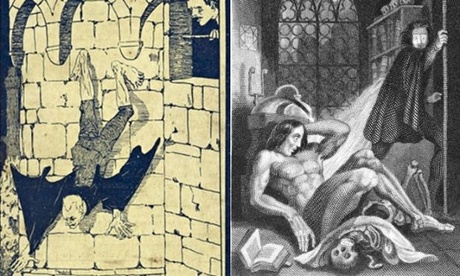
Christopher Lee played him with a certain glamour, Bela Lugosi with a horrible magnetism. But the actors’ famous portrayals of Dracula are a long way from the very first illustration of Bram Stoker’s creation, a bat-like, ancient, barefooted creature crawling down a wall that is far closer to the author’s 1897 description of the notorious count.
Part of the British Library’s new exhibition Terror and Wonder: the Gothic Imagination, which opens on 3 October and will be the UK’s largest showing of gothic literature, the image is from a 1901 edition of the novel – the first to include an illustration of the character. It shows Jonathan Harker looking down in horror at the count as the vampire crawls down the castle walls.
“At the this stage, the count genuinely does resemble the description of the character in the book: tall, thin, pale, old – although he looks younger after feeding – and moustachioed,” said curator Greg Buzwell. “The more glamorous renderings of the count, portraying him as a suave and sophisticated figure with a dangerous sexual magnetism – such as those given in the famous Hammer films by Christopher Lee, for example – were still many years away.”
The exhibition, intended to mark 250 years since Horace Walpole’s The Castle of Otranto inspired the gothic genre with its story of mysterious curses, secret passageways and terrified heroines, also features the first-ever image of Mary Shelley’s Frankenstein and his monster. Although the novel, Frankenstein, was first published anonymously in 1818, in 1831 Shelley released a revised version of the text, complete with the first illustration of the monster by the artist Theodor von Holst.
Showing the moment at which the doctor realises that his creation is alive, “Von Holst’s illustration is fascinating and evokes a dark gothic atmosphere brilliantly. The case of arcane volumes behind Frankenstein is lined with skulls, a skeleton lies on the floor and the whole scene is lit with an eerie light,” said Buzwell. “It’s the key moment from the novel, the scene where the horrific realisation of what he has done, and the dangers of attempting to play God, really comes home to Frankenstein.”
As well as displaying manuscripts of gothic classics from Robert Louis Stevenson’s The Strange Case of Dr Jekyll and Mr Hyde to Charles Dickens’s Oliver Twist, the exhibition will examine contemporary writers influenced by the genre, including Angela Carter and Mervyn Peake, and look at how gothic literature “has been an important reflection of society’s attitudes, angst and fears” over the past 250 years.
The infamous “Dear Boss” Jack the Ripper letter will be displayed in a section looking at Dr Jekyll and Sister Hyde, the Hammer film that brought together Jekyll, Hyde and Jack the Ripper, said Buzwell. The letter was received by the Central News Agency of London on 27 September 1888 and passed to the police two days later, said the curator, and achieved notoriety because of its line: “The next job I do I shall clip the lady’s ears off and send to the police just for jolly wouldn’t you”.
“When the body of Catherine Eddowes was discovered on 30 September it was noticed that her right ear lobe had been severed by the murderer,” said Buzwell. “The police were coming in for heavy criticism at the time for failing to catch the killer, and baiting their seemingly inept efforts was becoming something of a free for all and a national pastime. I suspect, even allowing for recent claims to have solved the mystery of the killer’s identity, doubt will always remain. I strongly suspect we will never know who committed the crimes, but that in itself only adds to their enduring macabre appeal. I think, aside from the eerie echo of events to come, one of the reasons the letter has an enduring appeal comes from the first words: ‘Dear Boss’ has a swagger and a sneer of contempt to it. ‘Dear Sir’ wouldn’t have been half so memorable.”
Buzwell said that the exhibition also examined “how the gothic imagination has shaped many other aspects of our lives, such as fashion, architecture, art, film and music”, adding: “I hope the show brings home to our visitors just how much inspiration we owe to the dark side of our imagination, and the enduring and beautiful impact it has had on our lives. In the right circumstances, fear is a delicious sensation.”
•Terror and Wonder: the Gothic Imagination is at the British Library, London, from 3 October until 20 January 2015.

